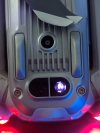What function does each couple of sensors have?
The infrared sensors (the ones that are more to the rear, that are very reflective) are the TOF sensors used to measure height. They are used for precision landing and bottom obstacle avoidance, that prevent you from slamming the drone into the ground when pushing the stick fully down even in sport mode. These can be easily confused by reflective surfaces such as mirrors, glass tables, car roofs and water, so be careful not try to land on one of those, and if you do, do not push the left stick fully down as the sensors might fail and the drone might fly into the surface at full speed.
The other sensors on the bottom (2 of them, on each side of the aux light, the ones that look the same to the obstacle avoidance sensors on the front and back) are VPS cameras, those are used for precision landing (hover 6m high for about 5 seconds after takeoff to activate precision landing) which accurately lands your drone in the (nearly) exact spot you took off from when using RTH mode. Those are also used for stabilizing the drone in non-GPS environments. If you have ever hovered indoors, you might have noticed that if enough light is present, and the floor below the drone is recognizable enough (with some patterns) then the drone might very accurately hold its position. That is called OPTI mode or Visual Positioning mode, it is automatically used if GPS is not available, however it only works up to 7 meters high. These cameras are used to track the visual movement of the surface below the drone, thus accurately knowing where it's drifting and correct that. If the sensors nor GPS are available, then the drone will be in ATTI mode, or No Positioning mode, the drone will drift away with the wind.
Note that the sensors do not work when flying higher than a certain altitude, in the
Air 2 it is around 7 meters, so they will be disabled when flying higher and not be used, they are used during takeoff and landing, and when GPS is not available.











